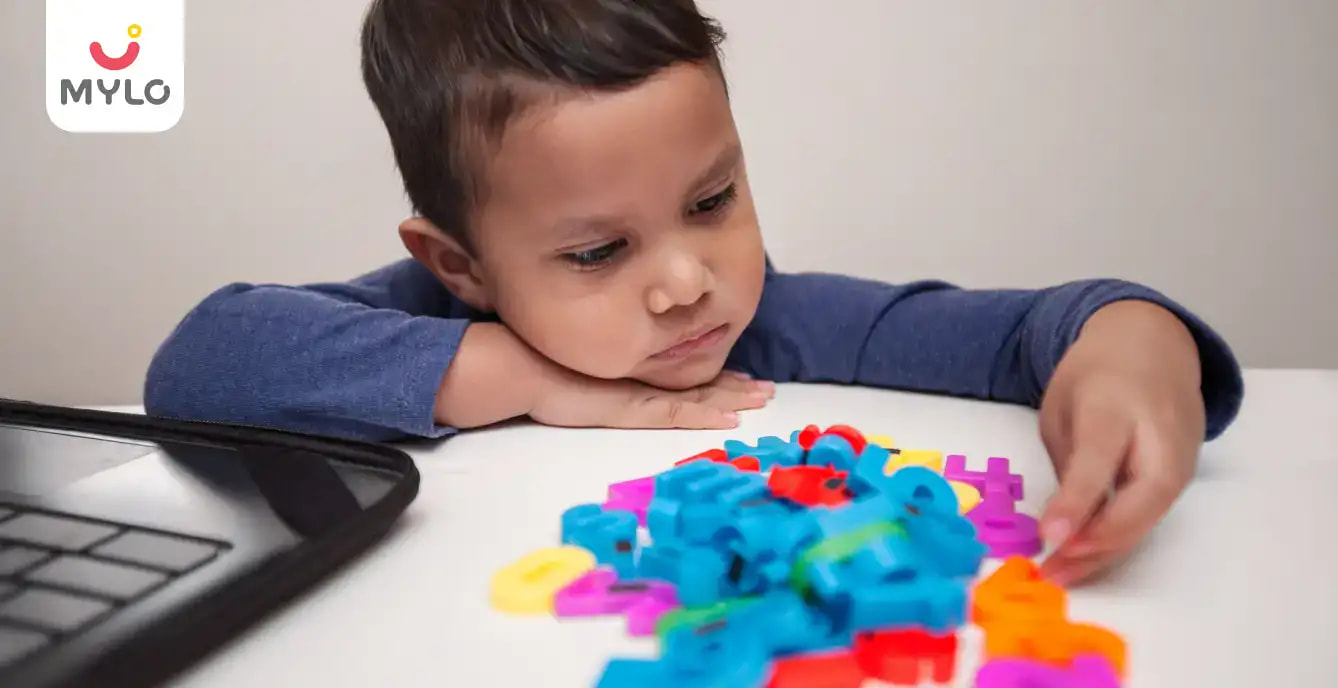Home

How Do I Know If My Toddler Has Sensory Processing Disorder?
In this Article

Baby Care
How Do I Know If My Toddler Has Sensory Processing Disorder?
Updated on 3 November 2023
Question parents of toddlers with behavioral and learning disorders if their children experience problems with sensory processing, and many of them will answer with a resounding "yes." Although it is generally accepted that toddlers with Autism Spectrum Disorders have difficulties integrating sensory input, it is now being thoroughly researched that children who are not on the spectrum may also have these difficulties to varying degrees.
What Is Sensory Processing Disorder?
Sensory processing disorder(SPD) is a neurological condition that affects how your brain processes sensory information from the senses. Depending on how they are affected, people with sensory processing disorder may be extra sensitive or not react to sensory information. Sensory information comprises things you see, hear, smell, taste, or touch. This disorder usually indicates you're overly sensitive to stimuli others aren't.
Children are more prone to have SPD than adults. However, adults can have symptoms too. Generally, these symptoms have existed in adults since childhood, and they have developed to deal with this disorder that lets them keep it from others. For example, children who have sensory problems may have an aversion to things that overstimulate their senses, such as loud environments, bright lights, or intense smells. Or, they may seek extra stimulation in environments that don't stimulate their senses enough.
There is some debate among doctors about whether sensory processing disorder is a separate disorder or whether it is a symptom of other disorders such as autism spectrum disorder, hyperactivity, attention deficit disorder, and anxiety. However, little is known about sensory issues or processing disorders, and more research is still needed.
What Is Sensory Processing?
You may have learned about the five senses in elementary school, but the fact is, you feel the world with more than just your five senses.
Sensory processing is commonly divided into eight main types, which include:
-
Proprioception: It is the " internal" feeling of awareness you have of your body. It's what enables you to maintain posture and motor control. For instance, it also tells you how you move and occupy space.
-
Vestibular: This term pertains to the inner ear's spatial recognition. It's what maintains your balance and coordination.
-
Interoception: This term refers to the sense of what's happening in your body. It can be better understood as how you "feel," which includes whether you feel hot or cold and your emotions.
-
Five senses: There are five ordinary senses - feel, hearing, taste, smell, and sight.
There is an inadequacy of research-based evidence to substantiate diagnosing this disorder. Most doctors and experts speculate that sensory issues are a component of another disorder or condition, such as autism spectrum disorder. The term " sensory processing disorder" is generally used in occupational therapy.
What Are The Signs And Symptoms Of Sensory Processing Disorder?
Depending on how a child processes different sensations, the symptoms of sensory processing problems differ. For example, children who are easily stimulated may possess hypersensitivity. This implies they are more sensitive to sensory inputs like light, sound, and touch. As a result, these sensations may disturb them more, cause them to lose focus in the presence of too much sensory information, or may also prompt them to act out.
Some children may also experience hyposensitivity. This implies they have reduced sensitivity to sensory outputs. The kind of sensitivity individual experiences may largely determine what their symptoms are. For instance, hypersensitive children may react as though everything is too loud or too bright. As a result, these children may have difficulty living in noisy rooms and adversely affect by smell. Sensory hypersensitivity may result in the following:
-
A low pain limit
-
Appearing clumsy
-
Escaping without regard for safety
-
Covering eyes or ears often
-
Selective food preferences or gagging while eating foods of certain textures
-
Avoiding hugs or sudden touches
-
The belief that soft touches are too hard
-
Difficulty regulating their emotions
-
Trouble focusing attention
-
Difficulty adapting responses
-
Behaviour issues
In contrast, hypersensitive children experience reduced sensitivity and crave interaction with the world around them. They may connect more with the surroundings to get more sensory feedback. This may make them appear hyperactive. In fact, they may just be trying to engage their senses more. Sensory hyposensitivity may result in the following:
-
A high pain limit
-
Banging into walls
-
Feeling things
-
Putting stuff into their mouth
-
Giving hugs
-
Slamming into other people or things
-
Not respecting personal space
-
Rocking and swaying
What Causes Sensory Issues In Children?
It is not clear what causes sensory processing disorders in toddlers. However, researchers believe it may have something to do with brain sensory pathways that process and organize information. Sensory processing difficulties are prevalent in autistic people. However, it is also not evident if sensory issues can occur independently or if another disorder causes them. However, many in the medical community think sensory processing difficulties are more of a red flag than a diagnosis.
A review and a short study suggest that pregnancy and delivery problems may be related to sensory processing issues, which are:
-
Premature delivery
-
Low birth weight
-
Parental stress
-
Alcohol or drug consumption during pregnancy
The risk factors for developing sensory processing disorder may include overexposure to specific chemicals and a lack of sensory stimulation in childhood. Abnormal brain activity could also change how the brain responds to senses and stimuli.
Are Sensory Issues Part Of Another Condition?
Many doctors don't recognize sensory disorders a separate disorders. But it is evident that some people have issues processing what they feel, see, smell, taste, or hear. In most cases, sensory problems happen in children, but adults may experience them too. Some children with altered sensory processing are on the autism spectrum.
Conditions or disorders connected to sensory problems can include:
-
Autism spectrum disorder(ASD)
Autistic people may have fluctuations in the neural pathways in their brain responsible for processing sensory information.
-
Attention deficit hyperactivity disorder(ADHD)
ADHD entails the capacity to filter out unnecessary sensory information, which can lead to sensory overload.
-
Schizophrenia
In people with this condition, abnormal mechanisms in the brain's sensory pathway establish and organize connections between neurons that can cause altered sensory and motor processing.
-
Sleep disorders
Sleep disorders, such as sleep deprivation, can result in delirium, which can induce temporary sensory processing problems.
-
Development delay
Developmental delays are also common in people with sensory conditions.
-
Brain injury
According to research, traumatic brain injury may be another possible cause of sensory processing disorder.
However, it is significant to note that children with ADHD experience hyperactivity for a different reason than children who have sensory problems. People with ADHD also have problems concentrating or sitting still. This is because they crave sensory interactions with the world or are bothered by their surroundings.
How Are Sensory Issues Diagnosed?
Sensory processing disorder isn't an officially acknowledged neurological condition. This means there are no established criteria for diagnosis. Instead, experts who assist children with sensory processing do so by inferring the best way to help the child from the child's behaviour and interactions with others.
Also, in some cases, professionals may use questionnaires such as sensory processing disorder toddlers quizzes or tests or sensory processing measures (SPM). These tests can help healthcare professionals, and educators better understand a child's sensory functioning.
If you doubt your child has sensory issues, these clues may indicate that it's time to consult a doctor:
-
The behaviour interrupts everyday life
-
Symptoms take a dramatic turn
-
Reactions have become too difficult to manage
-
The sensory issues accent their learning
Questions To Ask A Doctor
When stopping by a doctor to discuss problems with your child's sensory processing, ask any questions you may have about your child's behaviour and how you can best help them. Some questions you may want to ask to include the following:
-
Is there a diagnosis that can clarify my child's behaviour?
-
Can you propose any therapy that may help?
-
Will my child's sensory processing problems go away as they get older?
-
How can I help my child at home or in a different environment?
-
How can I help my child at school?
-
How can I help my child if they experience sensory overload?
-
How can I help a child with a sensory processing disorder?
What Is The Treatment For Sensory Issues?
There is no remedy for sensory issues or sensory processing disorders. Yet, some options for therapy may help.
-
Occupational therapy: An occupational therapist can support a child's practice or learn to do activities they usually avoid due to sensory issues. In school, therapists may also act with a child's teacher to help support their sensory requirements in the classroom.
-
Physical therapy: A physical therapist can assist develop a sensory diet. This is a list of activities formulated to satisfy the craving for sensory input, which may include jumping jacks or running in a place. Additional help like weighted or sensory vests or scheduled sensory breaks may also benefit.
-
Sensory integration therapy: Both occupational and physical therapy are the basis of sensory integration therapy. This approach may enable children to learn ways to react appropriately to their senses. It is also designed to help them realize how their experiences differ so that they can figure out a more typical response.
-
Sensory diet: Often, a sensory diet will supplement other sensory processing therapies disorder. A sensory diet isn't your regular food diet. Instead, it is a list of sensory activities for home and school formulated to help your child stay focused and organized during the day. Like sensory integration therapy, a sensory diet is customized based on your child's requirements. For example, a sensory diet in a school might include the following:
-
A duration every hour when your child could go for a ten-minute walk.
-
A moment twice a day when your child could play for ten minutes.
-
While working, access to in-class headphones so your child can listen to music.
-
Access to a desk chair bungee cord allows your child to move their legs while sitting in the classroom.
Is the cost of the procedure covered by health insurance is another concern. The answer is that insurance may not pay for sensory processing disorder treatment if the illness is not formally recognized. Get in touch with your insurance company to find out if services like occupational therapy are covered. Your child's sensory processing issue may be covered by insurance if it is a symptom of another, more severe disorder. It's best to double-check with your insurer to see what kind of coverage they'll supply for you.
Ways Parents Can Help
Parents can encourage their children with sensory processing issues by advocating for them so they can get the support they need. This may include:
-
Discussing with the doctor or pediatrician about the child's sensory processing.
-
Discuss the child's sensory processing disorder with the child's teacher and school support staff.
-
Seeking out help, including occupational therapy and physical therapy.
-
Often checking with the child about what they are feeling.
-
Educating their child on how they can let adults know if they need a break or are overstimulated.
-
Assisting their child's occupational or physical therapy goals with practice.
What Is The Prospect For Kids With Sensory Issues?
There is no remedy for sensory issues. Some children may encounter fewer issues; others may learn to cope with the experiences. There is not a lot of analysis on the outlook of children with altered sensory processing. There may be a link to mental health conditions.
Some doctors don't deal with sensory disorder issues alone but instead target the symptoms during treatment for a diagnosed condition, such as autism spectrum disorder or ADHD. Validated treatment options may be limited if you think your child has problems processing what they anticipate with their senses and has no other underlying medical condition. Because it's not assumed to be an official disorder, not everyone is interested in treating or speculating on solutions that haven't been reliably shown to be effective in changing behaviours.
Conclusion
Our senses tell us a great deal about the world, from how it smells and sounds to how we can be cautious. Your child might show signs of sensory issues if they have difficulty gathering and interpreting that sensory information. These may comprise difficulty in balance and coordination, moaning, being aggressive when needing attention, or jumping up and down often.
However, occupational therapy may help children and adults with sensory issues learn to cope with the world around them. The objective of the treatment is to lessen overreactions and find better outlets for their sensory experiences.
You may also like: https://mylofamily.com/article/top-10-maths-puzzles-for-kids-to-keep-them-busy-173360?



Written by
Vijay Kumar
Get baby's diet chart, and growth tips

Related Articles
Related Questions
Hello frnds..still no pain...doctor said head fix nhi hua hai..bt vagina me pain hai aur back pain bhi... anyone having same issues??

Kon kon c chije aisi hai jo pregnancy mei gas acidity jalan karti hain... Koi btayega plz bcz mujhe aksar khane ke baad hi samagh aata hai ki is chij se gas acidity jalan ho gyi hai. Please share your knowledge

I am 13 week pregnancy. Anyone having Storione-xt tablet. It better to have morning or night ???

Hlo to be moms....i hv a query...in my 9.5 wk i feel body joint pain like in ankle, knee, wrist, shoulder, toes....pain intensity is high...i cnt sleep....what should i do pls help....cn i cosult my doc.

Influenza and boostrix injection kisiko laga hai kya 8 month pregnancy me and q lagta hai ye plz reply me

Related Topics
RECENTLY PUBLISHED ARTICLES
our most recent articles

Diet & Nutrition
গর্ভাবস্থায় আলুবোখরা: উপকারিতা ও ঝুঁকি | Prunes During Pregnancy: Benefits & Risks in Bengali

Diet & Nutrition
গর্ভাবস্থায় হিং | ঝুঁকি, সুবিধা এবং অন্যান্য চিকিৎসা | Hing During Pregnancy | Risks, Benefits & Other Treatments in Bengali

Women Specific Issues
স্তনের উপর সাদা দাগ: লক্ষণ, কারণ এবং চিকিৎসা | White Spots on Nipple: Causes, Symptoms, and Treatments in Bengali

Diet & Nutrition
গর্ভাবস্থায় পোহা: উপকারিতা, ধরণ এবং রেসিপি | Poha During Pregnancy: Benefits, Types & Recipes in Bengali

Diet & Nutrition
গর্ভাবস্থায় মাছ: উপকারিতা এবং ঝুঁকি | Fish In Pregnancy: Benefits and Risks in Bengali

Diet & Nutrition
গর্ভাবস্থায় রেড ওয়াইন: পার্শ্ব প্রতিক্রিয়া এবং নির্দেশিকা | Red Wine During Pregnancy: Side Effects & Guidelines in Bengali
- ইনার থাই চ্যাফিং: কারণ, উপসর্গ এবং চিকিৎসা | Inner Thigh Chafing: Causes, Symptoms & Treatment in Bengali
- গর্ভাবস্থায় ব্রাউন রাইস: উপকারিতা ও সতর্কতা | Brown Rice During Pregnancy: Benefits & Precautions in Bengali
- Velamentous Cord Insertion - Precautions, Results & Safety
- Unlock the Secret to Flawless Skin: 7 Must-Have Qualities in a Face Serum
- Unlock the Secret to Radiant Skin: How Vitamin C Serum Can Transform Your Complexion
- Gender No Bar: 10 Reasons Why Everyone Needs a Body Lotion
- Unlock the Secret to Radiant Skin How to Choose the Perfect Body Lotion for Your Skin Type
- Top 10 Reasons to Apply a Body Lotion After Every Bath
- Communication in Toddlers: Milestones & Activities
- How to Improve Vocabulary for Toddlers?
- A Comprehensive Guide to Understanding Placenta Accreta
- Vulvovaginitis in Toddlers Causes, Symptoms and Treatment
- A Comprehensive Guide to Understanding Cerebral Palsy in Children
- Bitter Taste in Mouth During Pregnancy: Understanding the Causes and Remedies


AWARDS AND RECOGNITION

Mylo wins Forbes D2C Disruptor award

Mylo wins The Economic Times Promising Brands 2022
AS SEEN IN
















- Mylo Care: Effective and science-backed personal care and wellness solutions for a joyful you.
- Mylo Baby: Science-backed, gentle and effective personal care & hygiene range for your little one.
- Mylo Community: Trusted and empathetic community of 10mn+ parents and experts.
Product Categories
baby carrier | baby soap | baby wipes | stretch marks cream | baby cream | baby shampoo | baby massage oil | baby hair oil | stretch marks oil | baby body wash | baby powder | baby lotion | diaper rash cream | newborn diapers | teether | baby kajal | baby diapers | cloth diapers |








